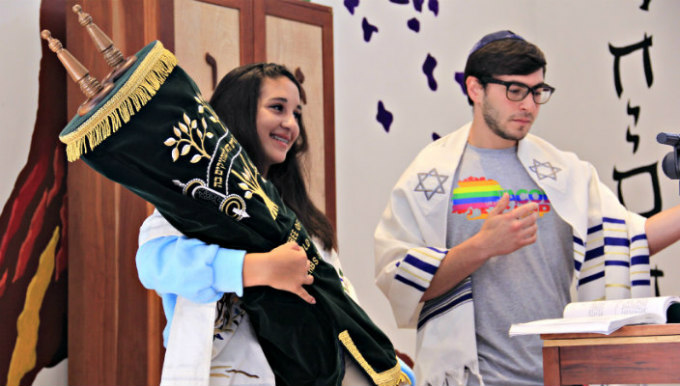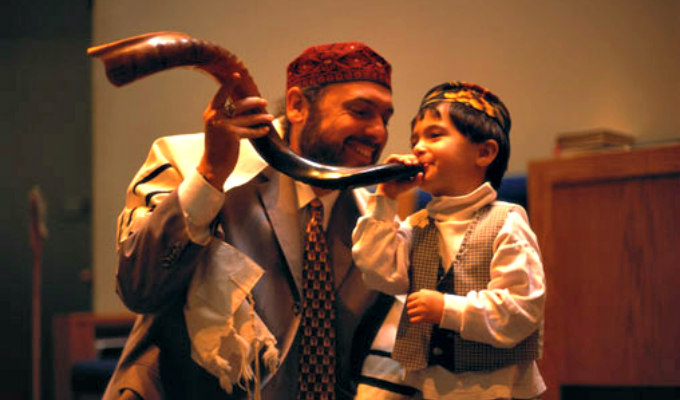
Our tradition holds that God gave Moses 613 mitzvot at Sinai. Yet in several texts our prophets or sages try to simplify and distill our tradition into core principles or values.
The prophet Micah taught that the Torah was built on just three commandments: “Do justly, love mercy, and walk humbly with your God” (Micah 6:8, based on Bavli Makkot 24a). Rabbi Akiba taught that the great rule of Torah is stated in the command found in Leviticus 19: “Love your neighbor as yourself” (Yerushalmi Nedarim 30b, quoting Lev. 19:18). And Rabbi Hillel famously summarized Torah “on one foot” when he taught a convert, “What is hateful to you, do not do unto others. The rest is commentary, go and learn” (Bavli Shabbat 31a).
These texts illustrate an ancient desire to synthesize the wisdom of Torah, and it makes me wonder: If we had to choose only one Torah portion to summarize the entire Torah, which would it be? We could make arguments in favor of various portions, but we would have to consider Parashat Va-et’chanan a strong contender.
In this week’s portion, we find a compilation of Torah’s “greatest hits,” both in law and narrative.
It opens with Moses’ reminder that we were an unruly bunch, grumbling and complaining along the way as we wandered through the wilderness. He tells us that we should be prepared for an imminent change of leadership as we prepare to enter the Promised Land (3:23-28). And he warns us to “heed the laws and rules” (4:1) that he has given and that we “shall not add anything… nor take anything away” from them (4:2) because all of “this Teaching” (literally, “this Torah,” in the Hebrew) comes from the covenant made with God at Horeb (4:10-13).
We find a restatement of the Ten Commandments (5:6-18), which for the first time are named “the 10 sayings, aseret had’varim” (4:13). We read the words of the Sh’ma, and the first paragraph of V’ahavta – verses stating our belief in God’s unique oneness and instructing us how to love God by teaching Torah to our children (6:4-9). We are reminded to recall our redemption from slavery in the land of Egypt (6:20-25) and are warned against turning to idols in several verses (4:15-20, 5:7, 7:4-5).
Perhaps most importantly, Va-et’chanan reinforces the idea of our own free will: While we cannot always control our circumstances, we are responsible for the ethical and spiritual choices we make as we walk our path through life.
We see this freedom implicitly in the way the text addresses keeping the laws and rules found in Torah. Moses would not have needed to warn us to keep the covenant (4:1, 4:40) and remember the commandments (4:9, 23), had our compliance been preordained. If we had no agency to murder, to steal, or to bear false witness, we would not need the Ten Commandments’ injunctions not to do those things. If it were easy to ignore the pull toward worshipping false gods, we would not need so many warnings to persist in our belief in God’s oneness.
Parashat Va-et’chanan demands our participation as interpreters of Torah. Moses speaks to “all the Israelites” with the instruction to “listen… study… and observe” the laws (5:1).
If the language of “all” wasn’t clear enough, he continues with a principle that will return again at the end of Deuteronomy: “It was not with our ancestors that the Eternal made this covenant, but with us, the living, every one of us who is here today” (5:3). Further still, we are commanded in the plural: “You all shall walk along the path that God has commanded” (5:30, translation mine).
The presence of the words “walk” (telechu) and “path” (derech) in the Hebrew relate directly to the classical Jewish systems of practice and law, called halachah. The word literally means “walking,” because we are supposed to infuse our movement through life with these ideas – this Teaching, this Torah. These verbs even make it into our liturgy in the V’ahavta paragraph taken from this portion: “You shall speak of them when you are sitting in your home or walking on the path” (6:7, translation mine.)
Of course, for some, adherence to halachah implies striving to fulfill as many of the 613 mitzvot as possible, as interpreted by the sages throughout centuries and passed down in the oral Torah, the traditional Jewish legal texts and law codes. But even for those of us who do not live by strict adherence to Jewish law, no Judaism exists without a halachah; a way to bring idea to action. In Engendering Judaism, Rabbi Dr. Rachel Adler teaches that “a halachah, a path-making, translates the stories and values of Judaism into ongoing action”
Va-et’chanan reminds us that we all have the ability and the invitation to walk that path. We all must be involved in translating the wisdom of our sacred texts to our contemporary lives, if they are to have any impact.
Finally, for the fans of the brevity in Hillel and Akiba’s teachings, Va-et’chanan also offers a verse that we can read as an overarching principle: “Do what is right and good in the sight of the Eternal, that it may go well with you…” (6:18).
We may not always find it easy to turn the wisdom of Torah into action, but just as we can fall back on principles like “Love thy neighbor” or “What is hateful unto you, do not do to others,” we can try to be guided by “what is right and good” as we make our ethical and spiritual choices through life.

What makes a good teacher? In the “greatest hits” of Parashat Va-et’chanan, we are given some clues to answer this question.
Moses has two discourses with the Israelite people sharing the essential precepts of monotheism and fundamental prayer in Jewish tradition, the Sh’ma and V’ahavta. In both of these, Moses commands the Israelites to teach the laws and rules to their children. The honorific that our Jewish tradition gives to Moses is Moshe Rabbeinu, “Moses our teacher” – not Moses our leader, our trailblazer, or our savior, not even Moses our father (like Abraham). The tradition remembers him as our teacher.
This is a powerful statement that sheds light on the legacy of Moses and our tradition. As a Jewish community Moses commands us to “v’sh’nantam l’vancha” (Deuteronomy 6:7), teach them to your children.
The Hebrew word, sh’nantam, to teach or to impress, stems from the same Hebrew root for the word “teeth.” To teach is to leave an impression, as teeth do when they bite down on something. This insight has always struck me. The goal of the teacher is to struggle or grapple with the most effective way to leave an impression on one’s students.
The teachers who made the largest impressions on my life challenged my thinking and my beliefs, pushed me to think critically and out of the box, yet remained guiding and encouraging during the process. It was not just the material these teachers conveyed but the teachers themselves who made the impressions. As we are taught during the Passover seder, there are Four Children, all with different learning styles, and our job is to be able to convey the meaning of Passover to each of them. Students have different types of intelligences, and successful teachers can instruct so the material clicks for all students.
Creating the opportunity for learning and making lasting impressions does not have to happen solely in the classroom. Again, Moses can be a source of inspiration. He instructs the Israelite people to embrace different ways and places of learning to teach God’s commandments: “Reciting them when you stay at home and when you are away, when you lie down and when you get up” (6:7). Additionally, “bind them as a sign on your hand and let them serve as a symbol on your forehead,” (6:8) can imply some people learn by doing and some by thinking.
Good teaching and making impressions takes time, effort, and different strategies and places for each learner. The people who have left the greatest mark on my life are those who have gone the extra distance to make personal connections with me and who cared about my thoughts and beliefs.
Explore Jewish Life and Get Inspired
Subscribe for Emails

